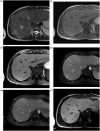Use of contrast agents in oncological imaging: magnetic resonance imaging
- PMID: 24060901
- PMCID: PMC3781607
- DOI: 10.1102/1470-7330.2013.9018
Use of contrast agents in oncological imaging: magnetic resonance imaging
Abstract
Magnetic resonance plays a leading role in the management of oncology patients, providing superior contrast resolution and greater sensitivity compared with other techniques, which enables more accurate tumor identification, characterization and staging. Contrast agents are widely used in clinical magnetic resonance imaging; approximately 40-50% of clinical scans are contrast enhanced. Most contrast agents are based on the paramagnetic gadolinium ion Gd3+, which is chelated to avoid the toxic effects of free gadolinium. Multiple factors such as molecule structure, molecule concentration, dose, field strength and temperature determine the longitudinal and transverse relaxation rates (R1 and R2, respectively) and thus the T1- and T2-relaxivities of these chelates. These T1- and T2-relaxivities, together with their pharmacokinetic properties (i.e. distribution and concentration in the area of interest), determine the radiologic efficacy of the gadolinium-based contrast agents.
Figures





Similar articles
-
Low-Molecular-Weight Iron Chelates May Be an Alternative to Gadolinium-based Contrast Agents for T1-weighted Contrast-enhanced MR Imaging.Radiology. 2018 Feb;286(2):537-546. doi: 10.1148/radiol.2017170116. Epub 2017 Sep 7. Radiology. 2018. PMID: 28880786
-
Gadolinium-labeled quantum dots for molecular magnetic resonance imaging: R1 versus R2 mapping.Magn Reson Med. 2010 Jul;64(1):291-8. doi: 10.1002/mrm.22342. Magn Reson Med. 2010. PMID: 20572132
-
Current uses of gadolinium chelates for clinical magnetic resonance imaging examination of the liver.Top Magn Reson Imaging. 1998 Jun;9(3):141-66. Top Magn Reson Imaging. 1998. PMID: 9621404 Review.
-
Magnetic resonance imaging (MRI) contrast agents for tumor diagnosis.J Healthc Eng. 2013;4(1):23-45. doi: 10.1260/2040-2295.4.1.23. J Healthc Eng. 2013. PMID: 23502248 Review.
-
Evaluation of Gadopiclenol and P846, 2 High-Relaxivity Macrocyclic Magnetic Resonance Contrast Agents Without Protein Binding, in a Rodent Model of Hepatic Metastases: Potential Solutions for Improved Enhancement at Ultrahigh Field Strength.Invest Radiol. 2019 Sep;54(9):549-558. doi: 10.1097/RLI.0000000000000572. Invest Radiol. 2019. PMID: 31033675
Cited by
-
Regulation of species metabolism in synthetic community systems by environmental pH oscillations.Nat Commun. 2023 Nov 18;14(1):7507. doi: 10.1038/s41467-023-43398-6. Nat Commun. 2023. PMID: 37980410 Free PMC article.
-
MRI-CEST assessment of tumour perfusion using X-ray iodinated agents: comparison with a conventional Gd-based agent.Eur Radiol. 2017 May;27(5):2170-2179. doi: 10.1007/s00330-016-4552-7. Epub 2016 Aug 29. Eur Radiol. 2017. PMID: 27572810
-
Randomized study of the effect of gadopiclenol, a new gadolinium-based contrast agent, on the QTc interval in healthy subjects.Br J Clin Pharmacol. 2020 Nov;86(11):2174-2181. doi: 10.1111/bcp.14309. Epub 2020 Apr 27. Br J Clin Pharmacol. 2020. PMID: 32302009 Free PMC article. Clinical Trial.
-
Iron(iii) chelated paramagnetic polymeric nanoparticle formulation as a next-generation T 1-weighted MRI contrast agent.RSC Adv. 2021 Sep 29;11(51):32216-32226. doi: 10.1039/d1ra05544e. eCollection 2021 Sep 27. RSC Adv. 2021. PMID: 35495502 Free PMC article.
-
Development of Resorbable Phosphate-Based Glass Microspheres as MRI Contrast Media Agents.Molecules. 2024 Sep 10;29(18):4296. doi: 10.3390/molecules29184296. Molecules. 2024. PMID: 39339291 Free PMC article.
References
-
- Lin SP, Brown JJ. MR contrast agents: physical and pharmacologic basics. J Magn Reson Imaging. 2007;25:884–899. - PubMed
-
- Bellin FM, Van Der Molen AJ. Extracellular gadolinium-based contrast media: an overview. Eur J Radiol. 2008;66:160–167. - PubMed
-
- Giesel FL, von Tengg-Kobligk F, Wilkinson LD, et al. Influence of human serum albumin on longitudinal and transverse relaxation rates (R1 and R2) of magnetic resonance contrast agents. Invest Radiol. 2006;41:222–228. - PubMed
-
- Rohrer M, Bauer H, Mintorovitch J, Requardt M, Weinmann H-J. Comparison of magnetic properties of MRI contrast media solutions at different magnetic field strengths. Invest Radiol. 2005;40:715–724. - PubMed
Publication types
MeSH terms
Substances
LinkOut - more resources
Full Text Sources
Other Literature Sources
Medical
